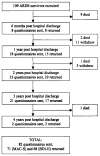Self-reported symptoms of depression and memory dysfunction in survivors of ARDS
- PMID: 19265087
- PMCID: PMC5233444
- DOI: 10.1378/chest.08-0974
Self-reported symptoms of depression and memory dysfunction in survivors of ARDS
Abstract
Background: Survivors of ARDS have well documented physical limitations, but psychological effects are less clear. We determined the prevalence of self-reported depression and memory dysfunction in ARDS survivors.
Methods: Six to 48 (median 22) months after ICU discharge, we administered instruments assessing depression symptoms (Beck Depression Inventory-II [BDI-II]) and memory dysfunction (Memory Assessment Clinics Self-Rating Scale [MAC-S]) to 82 ARDS patients who were enrolled in a prospective cohort study in four university-affiliated ICUs.
Results: Sixty-one (74%), 64 (78%), and 61 (74%) patients fully completed the BDI-II, MAC-S (Ability subscale), and MAC-S (Frequency of Occurrence subscale) instruments. Responders (similar to nonresponders) were young (median 42 years, interquartile range [IQR] 35 to 56), with high admission illness severity and organ dysfunction. The median BDI-II score was 12 (IQR 5 to 25). Twenty-five (41%) patients reported moderate-severe depression symptoms and were less likely to return to work than those with minimal-mild symptoms (8/25 [32%] vs 25/36 [69%]; p = 0.005). Median MAC-S (Ability) and MAC-S (Frequency of Occurrence) scores were 76 (IQR 61 to 93) and 91 (IQR 77 to 102), respectively; 8%, 16%, and 20% scored > 2, > 1.5, and > 1 SD(s), respectively, below age-adjusted population norms for each subscale. BDI-II and MAC-S scores were negatively correlated (Spearman coefficient -0.58 and -0.50 for Ability and Frequency of Occurrence subscales, respectively; p < 0.0001). Univariable analyses showed no demographic or illness-severity predictors of BDI-II (including the Cognitive subscale) or MAC-S (both subscales); results were similar when restricted to patients whose primary language was English.
Conclusions: ARDS survivors report a high prevalence of depression symptoms and a lower prevalence of memory dysfunction 6 to 48 months after ICU discharge. Depression symptoms may hinder the return to work, or patients may report these symptoms because of inability to re-enter the workforce.
Figures



Similar articles
-
Self-reported depressive symptoms and memory complaints in survivors five years after ARDS.Chest. 2011 Dec;140(6):1484-1493. doi: 10.1378/chest.11-1667. Epub 2011 Oct 13. Chest. 2011. PMID: 21998261
-
Determinants of Depressive Symptoms at 1 Year Following ICU Discharge in Survivors of ≥ 7 Days of Mechanical Ventilation: Results From the RECOVER Program, a Secondary Analysis of a Prospective Multicenter Cohort Study.Chest. 2019 Sep;156(3):466-476. doi: 10.1016/j.chest.2019.04.104. Epub 2019 May 15. Chest. 2019. PMID: 31102611
-
[Quality of results of therapy of acute respiratory failure : changes over a period of two decades].Anaesthesist. 2013 Apr;62(4):261-70. doi: 10.1007/s00101-013-2156-z. Epub 2013 Apr 6. Anaesthesist. 2013. PMID: 23558717 German.
-
Association of COVID-19 Acute Respiratory Distress Syndrome With Symptoms of Posttraumatic Stress Disorder in Family Members After ICU Discharge.JAMA. 2022 Mar 15;327(11):1042-1050. doi: 10.1001/jama.2022.2017. JAMA. 2022. PMID: 35179564 Free PMC article.
-
Folic acid supplementation and malaria susceptibility and severity among people taking antifolate antimalarial drugs in endemic areas.Cochrane Database Syst Rev. 2022 Feb 1;2(2022):CD014217. doi: 10.1002/14651858.CD014217. Cochrane Database Syst Rev. 2022. PMID: 36321557 Free PMC article.
Cited by
-
Neuromuscular and neuropsychological assessments in survivors of acute respiratory distress syndrome: exploratory comparisons with an at-risk cohort.Neurocrit Care. 2015 Jun;22(3):395-402. doi: 10.1007/s12028-014-0087-4. Neurocrit Care. 2015. PMID: 25450720
-
Participant Retention in Follow-Up Studies of Acute Respiratory Failure Survivors.Respir Care. 2020 Sep;65(9):1382-1391. doi: 10.4187/respcare.07461. Epub 2020 Mar 31. Respir Care. 2020. PMID: 32234765 Free PMC article. Review.
-
The association between intensive care unit admission and subsequent depression in patients with diabetes.Int J Geriatr Psychiatry. 2012 Jan;27(1):22-30. doi: 10.1002/gps.2684. Epub 2011 Feb 9. Int J Geriatr Psychiatry. 2012. PMID: 21308790 Free PMC article.
-
Postintensive care syndrome in COVID-19. Unicentric pilot study. Calm does not come after the storm.Med Clin (Engl Ed). 2022 Oct 7;159(7):321-326. doi: 10.1016/j.medcle.2021.11.013. Epub 2022 Sep 5. Med Clin (Engl Ed). 2022. PMID: 36091872 Free PMC article.
-
An exploration of social and economic outcome and associated health-related quality of life after critical illness in general intensive care unit survivors: a 12-month follow-up study.Crit Care. 2013 May 28;17(3):R100. doi: 10.1186/cc12745. Crit Care. 2013. PMID: 23714692 Free PMC article.
References
-
- Bernard GR, Artigas A, Brigham KL, et al. The American-European Consensus Conference on ARDS: definitions, mechanisms, relevant outcomes, and clinical trial coordination. Am J Respir Crit Care Med. 1994;149:819–824. - PubMed
-
- Rubenfeld GD, Caldwell E, Peabody E, et al. Incidence and outcomes of acute lung injury. N Engl J Med. 2005;353:1685–1693. - PubMed
-
- Brun-Buisson C, Minelli C, Bertolini G, et al. Epidemiology and outcome of acute lung injury in European intensive care units: results from the ALIVE study. Intensive Care Med. 2004;30:51–61. - PubMed
-
- Estenssoro E, Dubin A, Laffaire E, et al. Incidence, clinical course, and outcome in 217 patients with acute respiratory distress syndrome. Crit Care Med. 2002;30:2450–2456. - PubMed
-
- Arroliga AC, Ghamra ZW, Perez TA, et al. Incidence of ARDS in an adult population of northeast Ohio. Chest. 2002;121:1972–1976. - PubMed
Publication types
MeSH terms
Grants and funding
LinkOut - more resources
Full Text Sources
Medical
Miscellaneous

